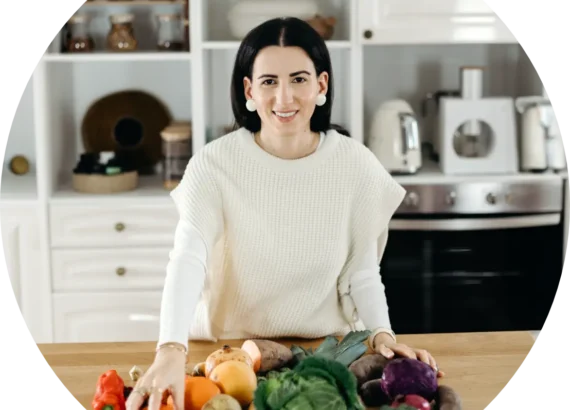10 quick, plant-based stew & warm winter soup recipes
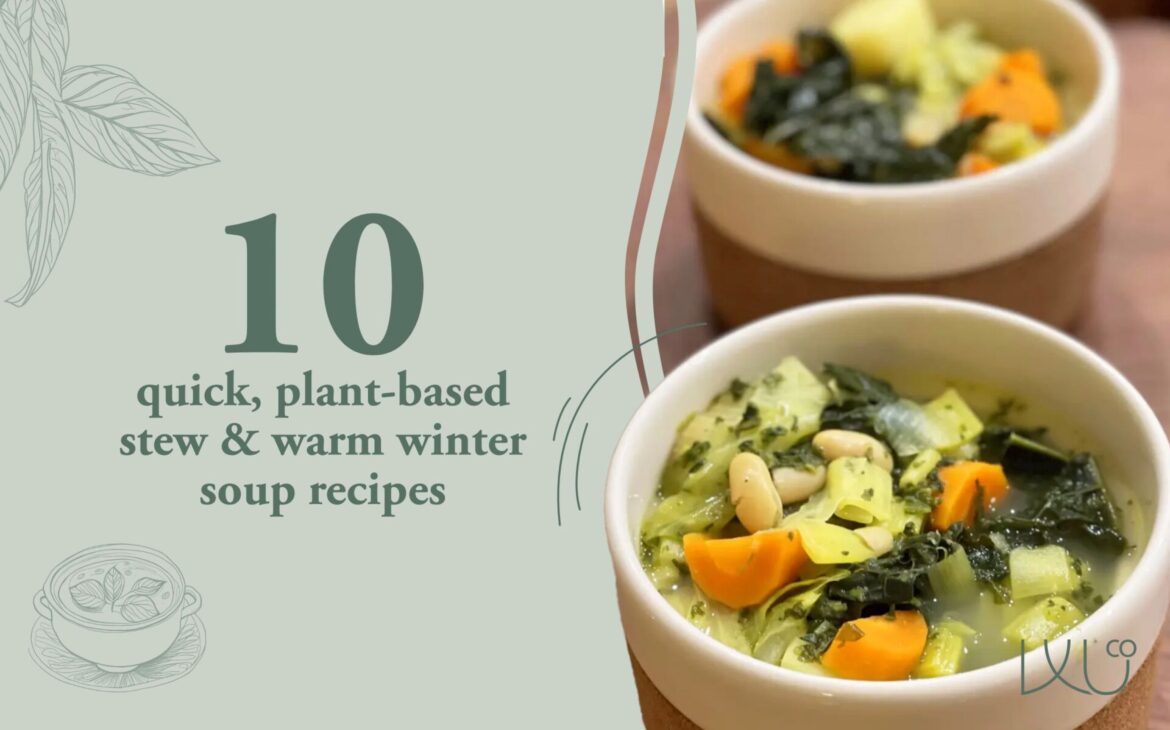
Why eat seasonally: benefits of warm foods in the cold months
Why is a warm winter soup good for you in the cold months?
Eating fresh, local fruits and vegetables that are in season doesn’t only mean you will benefit from super delicious and flavorful products, it also comes with significant health benefits:
- Fresh seasonal fruits and vegetables are rich in minerals and vitamins
- A diverse gut microbiome is promoted by fresh seasonal fruits and vegetables
Our bodies strive to live in sync with nature and the seasons’ natural cycles. Isn’t that a beautiful phenomenon? Eating winter vegetables in the winter is essential for your body to get the nutrients it needs. Different types of foods will benefit your body depending on the weather.
When it’s hot outside, namely in summer, it’s beneficial to eat vegetables because they naturally have more water in them (tomatoes, cucumber, watermelon etc) and have a natural cooling and hydrating impact. In winter, the opposite is the case with winter vegetables.
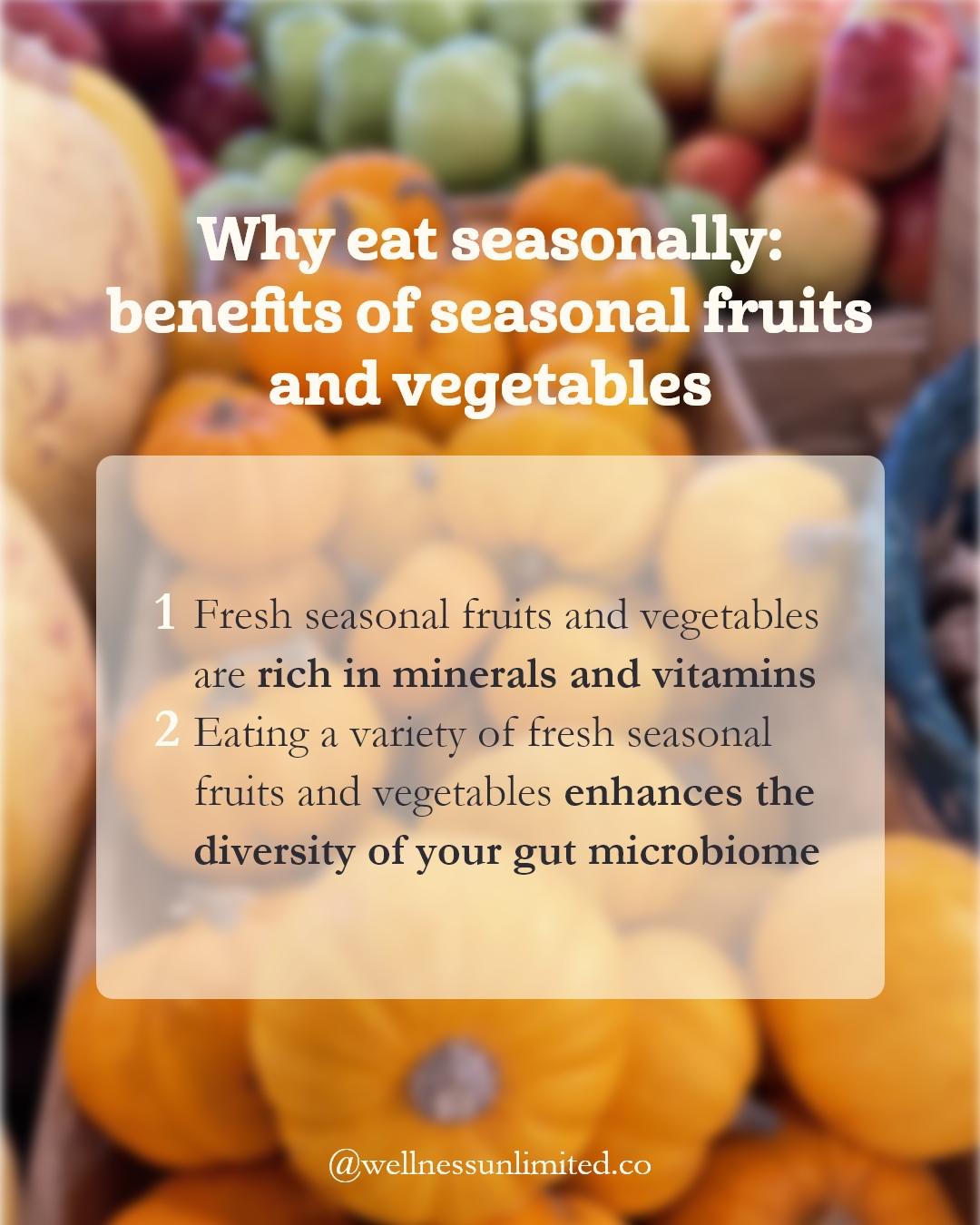
In fall, plants begin to draw their energy inwards. At the same time, we should look to nourish ourselves more deeply with hearty foods. Then, when winter arrives, the plants’ energy descends down into the roots, and your body can benefit from even more hearty and warming stews.
This means that eating cold foods and salads in winter may not effectively prepare your body to adapt to the current season and temperature. Warm winter soups, on the other hand, are a great way to hit your micronutrient intake, not least because vegetables are cooked through and easier to digest.
Why choose organic vegetables for a warm winter soup?
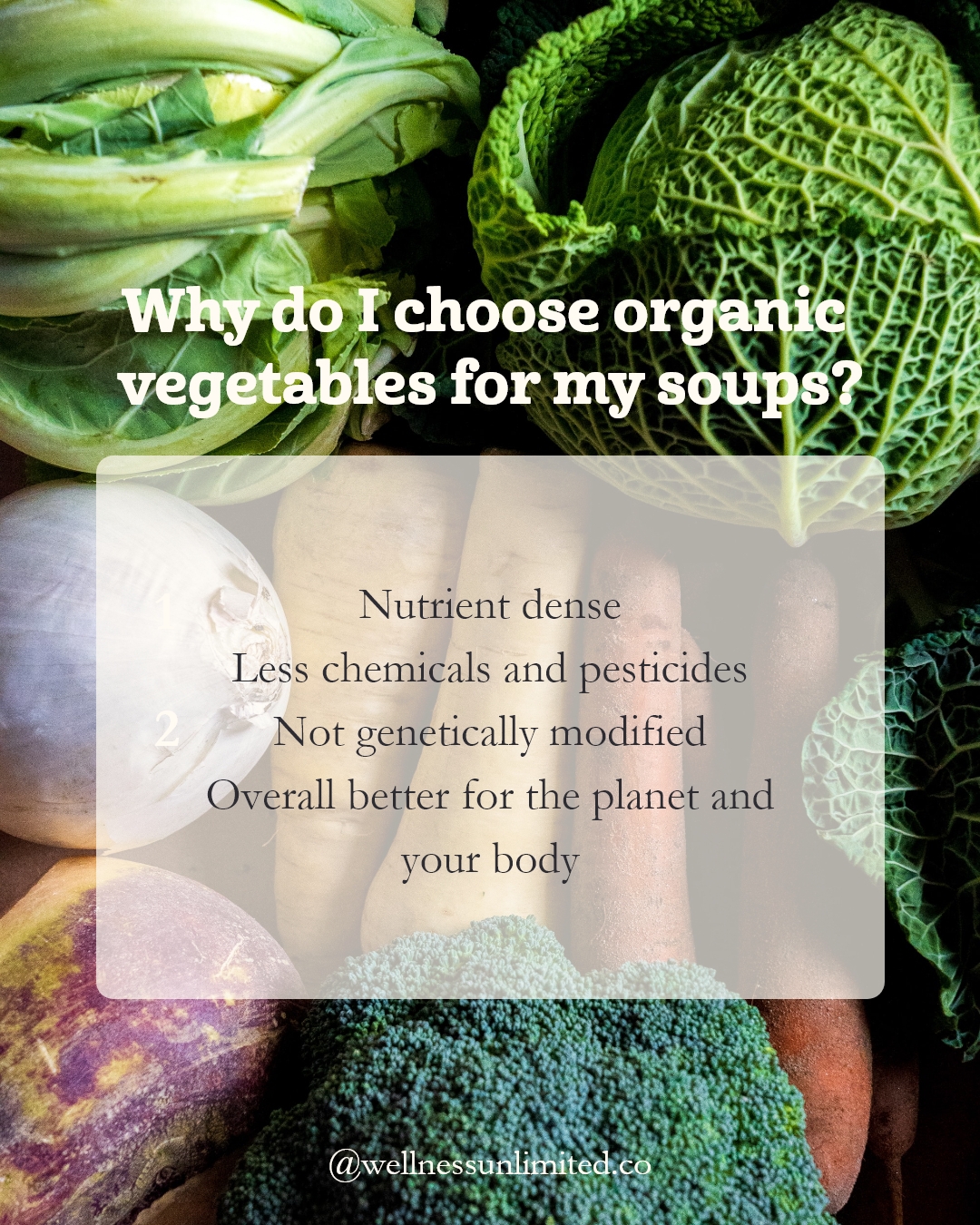
I always go for organic vegetables to ensure they’re nutrient dense, contain less chemicals and pesticides, have not been genetically modified, and are overall better for the planet and your body. I mainly shop at local organic shops, but main supermarkets and even low cost ones have begun offering affordable organic vegetables. This means they are more widely accessible, which comes in handy for anyone leading a busy life.
How to store soup and stews
A major advantage of warm winter soups is that they’re easy and quick to make, affordable, and can be cooked in batches.
I always prepare more soup than I can eat in one go, this way I can have more soup the next day! I also freeze a portion or two for when I don’t have time to cook, lack fresh ingredients or just don’t feel like cooking! This trick is also super handy if you’re run down and feeling poorly – nothing beats a nutrient-dense warm winter soup on those days.
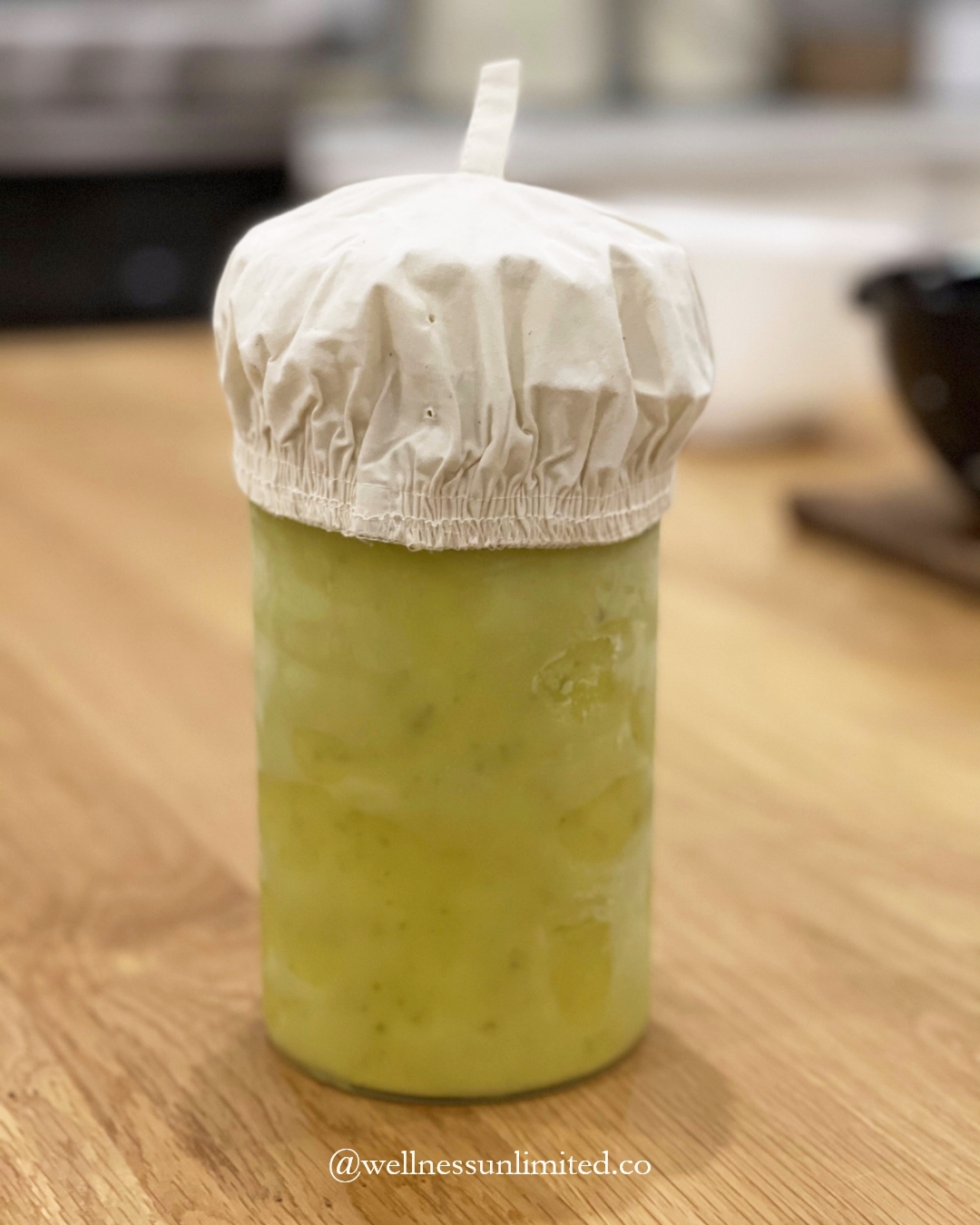
So how do you store your warm winter soup?
All you have to do is freeze them in a glass jar and then either leave them out for a bit or soften them slightly in the microwave before reheating them in a pot. Once the soup is ready, I always add a drizzle of extra virgin olive oil, sometimes seeds or dried fruits like flaxseeds, hemp seeds or dates. If I’m feeling extra indulgent, I might add some coconut yogurt, cashew cream or grated cheese. This will also depend on the way you feel that day, get creative with your soups and you’ll be surprised!
Intuitive cooking: it’s simpler than you think
My approach to cooking soups is always to go with the flow, see what vegetables are available at the shop and what is in season.
Sometimes I know which warm winter soup I want to cook and try to find ingredients that match the recipe, though more often than not I buy the vegetables and then make the soup according to what I have.
Any ingredients in the recipes below can be swapped or replaced with other vegetables that you have on hand or prefer the taste of. The most important things are to ensure their seasonality as much as possible and to use a variety of vegetables and colors to get all the benefits they offer to your gut health and immune system.
My staple ingredients:
- Extra virgin olive oil;
- Turmeric;
- Cumin
I use these in almost every meal I cook!
I also don’t always use specific measures. One day I might use 3 carrots, but on another day I may use 2 depending on what I have available. I might not have Kale on hand, so I’ll substitute it with spinach. When I cook, I cook from my heart. I make sure to taste the soup and keep an eye on the consistency to tell which ingredients and measures are needed rather than focusing on specific quantities.
While writing this post, the word intuitive came to mind as a perfect description of my cooking style. A quick search online revealed to me that intuitive cooking is already a widely used term and has health benefits, which doesn’t surprise me at all!
What is Intuitive cooking?
Intuitive cooking is the concept of using all of your senses (especially taste), your memory, and your experience. It is rooted in your curiosity, your appreciation for good food, and the knowledge to achieve a desired result.
Cooking intuitively with confidence requires practice, which involves making mistakes. Just like anything else in life, we learn and progress by getting things right and wrong.
It’s hard to try and replicate even your own recipes sometimes. The conditions you cook in may not always be the same, from the cookware you use, to the temperature or the quality of the ingredients themselves, or even your current state of mind.
Having said that, I recommend always writing down the recipe when you make something you like. Do it on the same day, otherwise you’ll likely have forgotten half of the steps when you want to replicate it in the future. That’s why I started sharing my recipes on Instagram in the first place, and I always go back to that when I want to cook something I have listed before. It’s so handy and like creating your own little recipe book. Whether you do this digitally or on paper makes no difference, whatever is easiest for you. If you’re ever out of inspiration, you can browse and quickly find something that’s easy to make and you know you like.
When we put too much pressure on ourselves while cooking, that’s often when things go wrong. When we allow our creative selves to guide the process and trust our feelings, we can cook delicious food. At least this is what I have found and continue to experience!
The recipes below are for inspiration purposes – feel free to make them your own!
Stews and warm winter soup ideas
All the stews and soups recipes below are plant based and naturally gluten free, but you can always swap ingredients depending on your dietary preferences and what you have at home.
Just before we dive into the recipes, let’s first take a look at what tools you will need to cook them!
5 must have utensils to cook your warm winter soup
- A deep steel or nonstick pot;
- A cutting knife and board to chop your vegetables;
- A wooden spoon to stir;
- A mixer (ideally hand-free so you can mix in the same recipient).
1. Plant Based Garbure
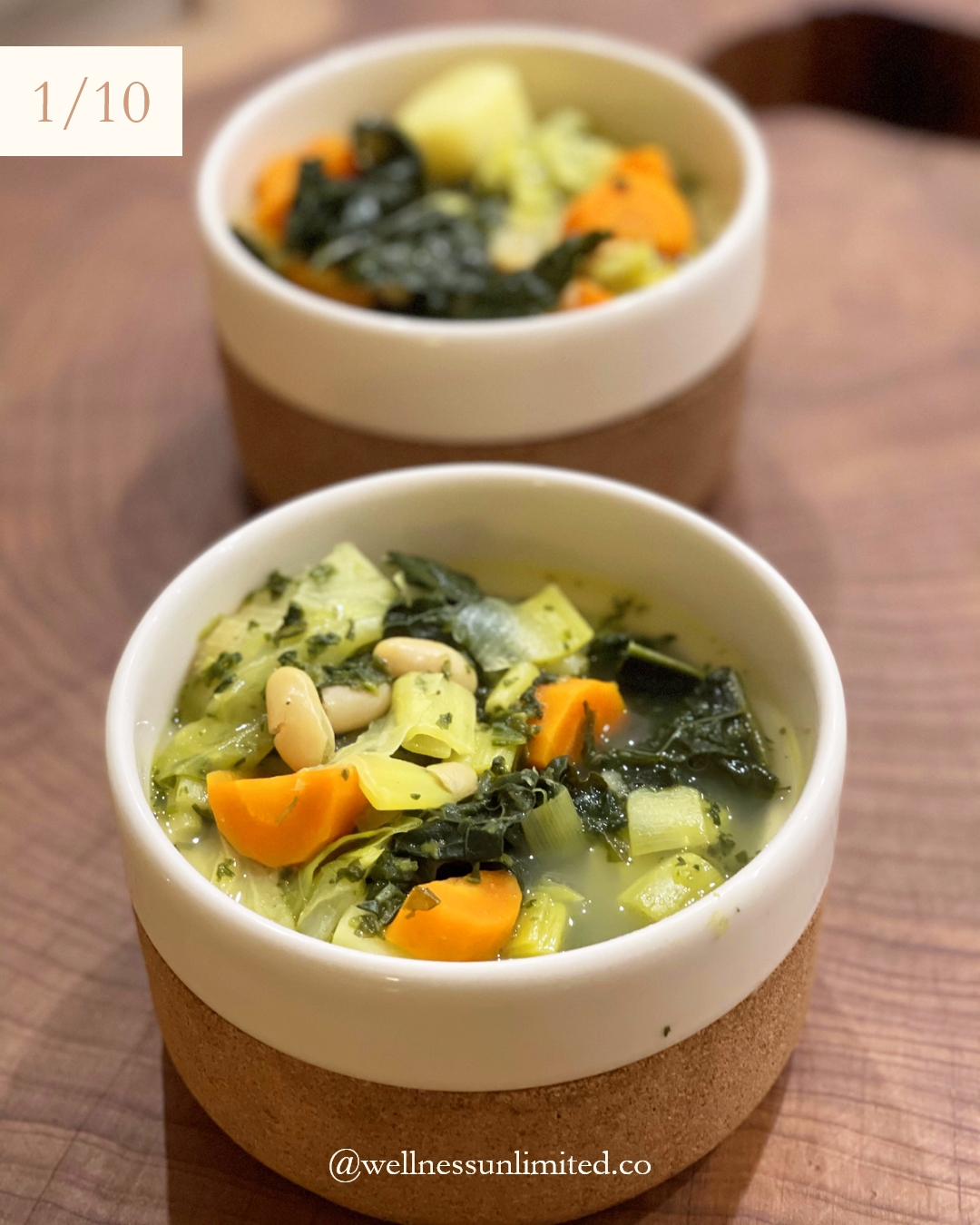
My take on a garbure, a stew originating in the Pyrenees, where I come from.
This is my go to warm winter soup in the colder months and, to be honest, all year round. Anytime I feel a bit run down I make this soup. The ingredients are so easy to find and it’s super quick to make.
Ingredients:
- Extra virgin olive oil
- 1 onion
- 2 to 3 large carrots
- 2 to 3 medium potatoes
- 1 courgette
- 1 leek
- 6 cubes frozen spinach
- Few leaves of fresh kale
- Half a small cabbage
- 1 big jar of white beans
- Spices: turmeric, pepper
- 1L of water
Method:
- Saute the onion in extra virgin olive oil;
- While your onion is softening, dice all your vegetables in medium chunks;
- Add in all the vegetable and stir for a few minutes;
- Add the turmeric and stir everything together;
- Rinse your white beans and toss them in;
- Add the frozen spinach;
- Pour in the water, season to taste (salt / pepper);
- Bring to a boil for 5 to 10 minutes;
- Let it cook for 15 to 20 min;
- To check if it’s ready, try a piece of carrot and potato, if they’re soft you’re good to go, if they’re too hard leave then cook a little longer until soft.
2. Squash Moong Dal
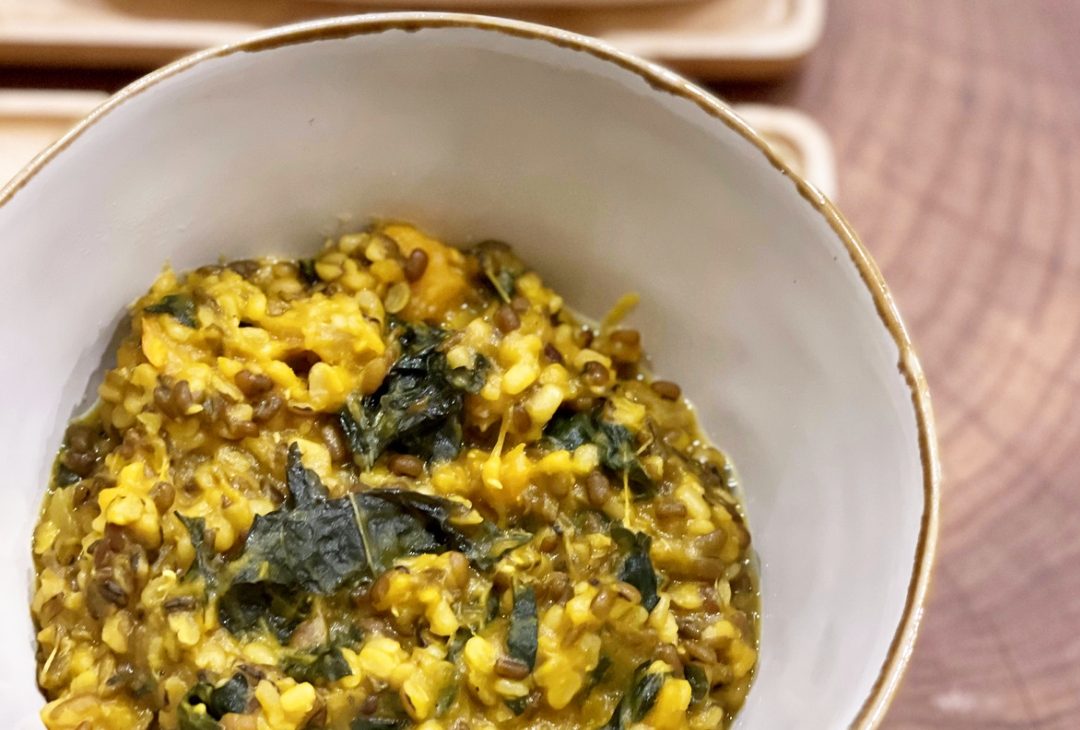
Ingredients:
- Extra virgin olive oil
- 2 shallots
- Garlic
- Ginger
- Spices turmeric, cumin, mustard seeds, cumin seeds
- 2 cups moong dal (split green lentils)
- 2 cups veg stock
- 1 whole medium size squash or small pumpkin (I used a red kuri squash)
- 1 bunch of fresh kale
- 200ml coconut milk
- Juice of 1 lemon
Method:
- Chop the top of your squash carefully and put it in the oven at 160°C whole with extra virgin olive oil over the top. Wait until it melts and you can scoop up the squash puree;
- Saute the shallots in extra virgin olive oil. Once softened, add in thinly cut garlic and ginger, stir for another few minutes then add in the spices and keep stirring for a minute or so;
- Add in the washed lentils, give it a stir and add your veg stock;
- Then add in your squash puree and keep stirring. Salt to taste;
- Add the kale leaves cut roughly and finish by pouring the coconut milk and lemon juice;
- Bring to a boil until the lentils are fully cooked.
3. My Grandmother's Watercress Soup
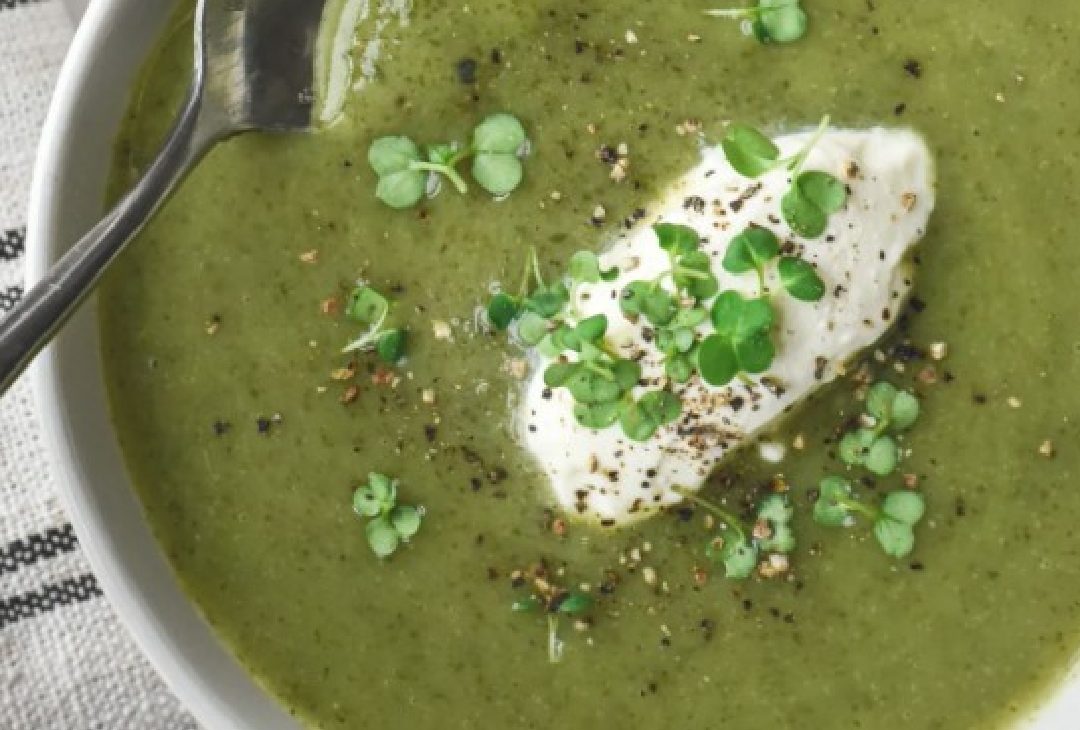
Ingredients:
- Extra virgin olive oil
- 1 onion
- 1 bunch watercress
- 2 parsnips
- 2 potatoes
- Water
- Spice: turmeric
- Vegan yogurt
- Hemp seeds
Method:
- Saute the onion in extra virgin olive oil. Add the vegetables cut in small to medium chunks;
- Season to taste with salt and pepper and I added some turmeric (not part of the original recipe). Pour in the water;
- Once the vegetables are cooked and soft, remove from the stove and blend until smooth;
- Bring back to the stove for 5 minutes;
- Normally, my family would serve this with creme fraiche, which I have replaced with vegan coconut yogurt and topped with hemp seeds.
4. Potato Leek Soup
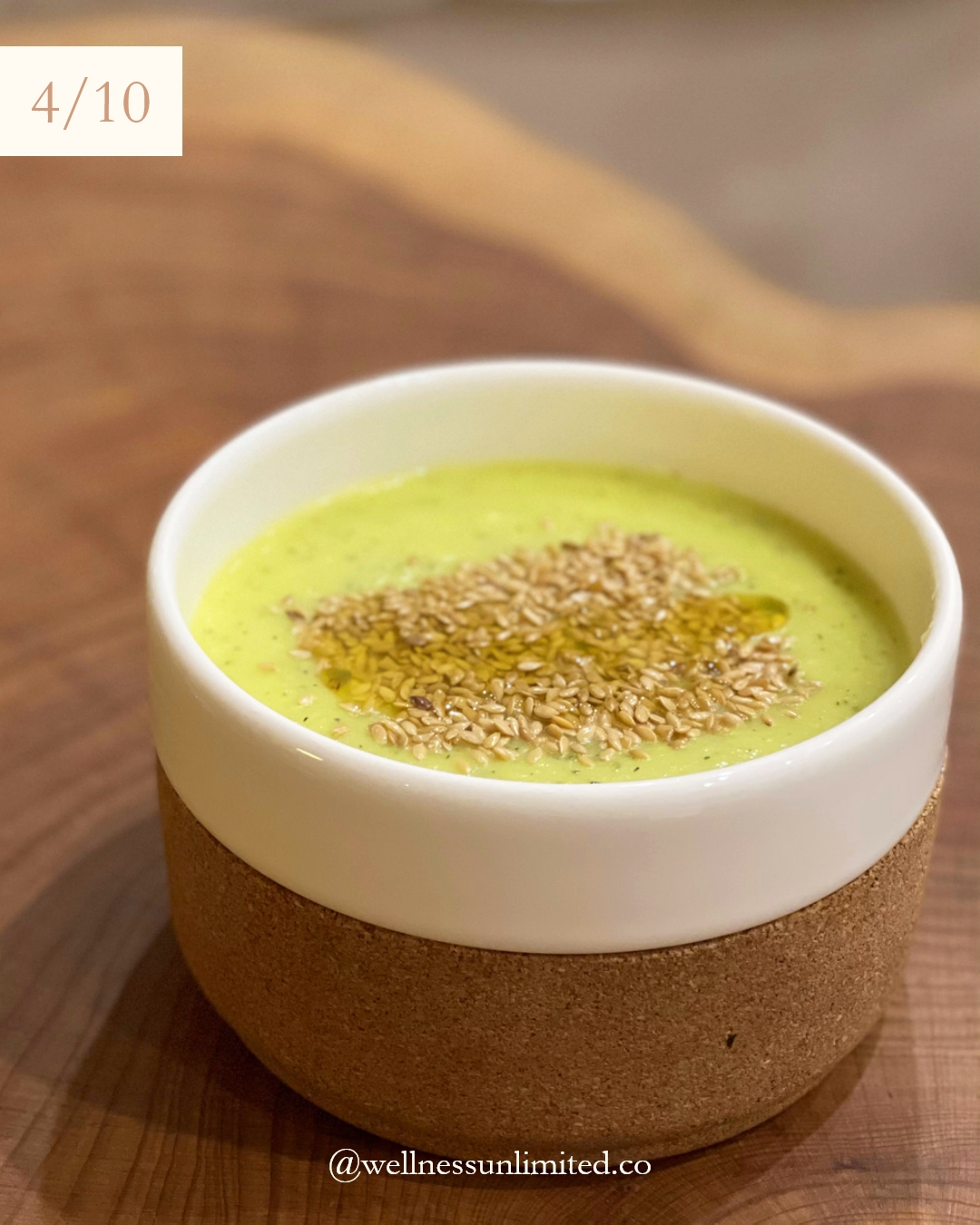
Ingredients:
- Extra virgin olive oil
- 1 onion
- 2 potatoes
- 2 leeks
- 1 courgette
- Spices cumin, salt and pepper
- 5 to 6 cups of water
- Flax or hemp seeds
Method:
- Saute the onion in extra virgin olive oil;
- Add in the vegetables roughly chopped (doesn’t need to be pretty or regular as they will be blended). Add the spices and stir. Pour in the water and bring to a boil;
- Season to taste with salt and pepper;
- Once the vegetables are cooked, remove from the stove and blend until you achieve a smooth texture. Bring back to the stove for 5 minutes;
- Can serve with a drizzle of olive oil and some seeds on top for a bit of crunch and extra nutrients.
5. Ginger Carrot Soup
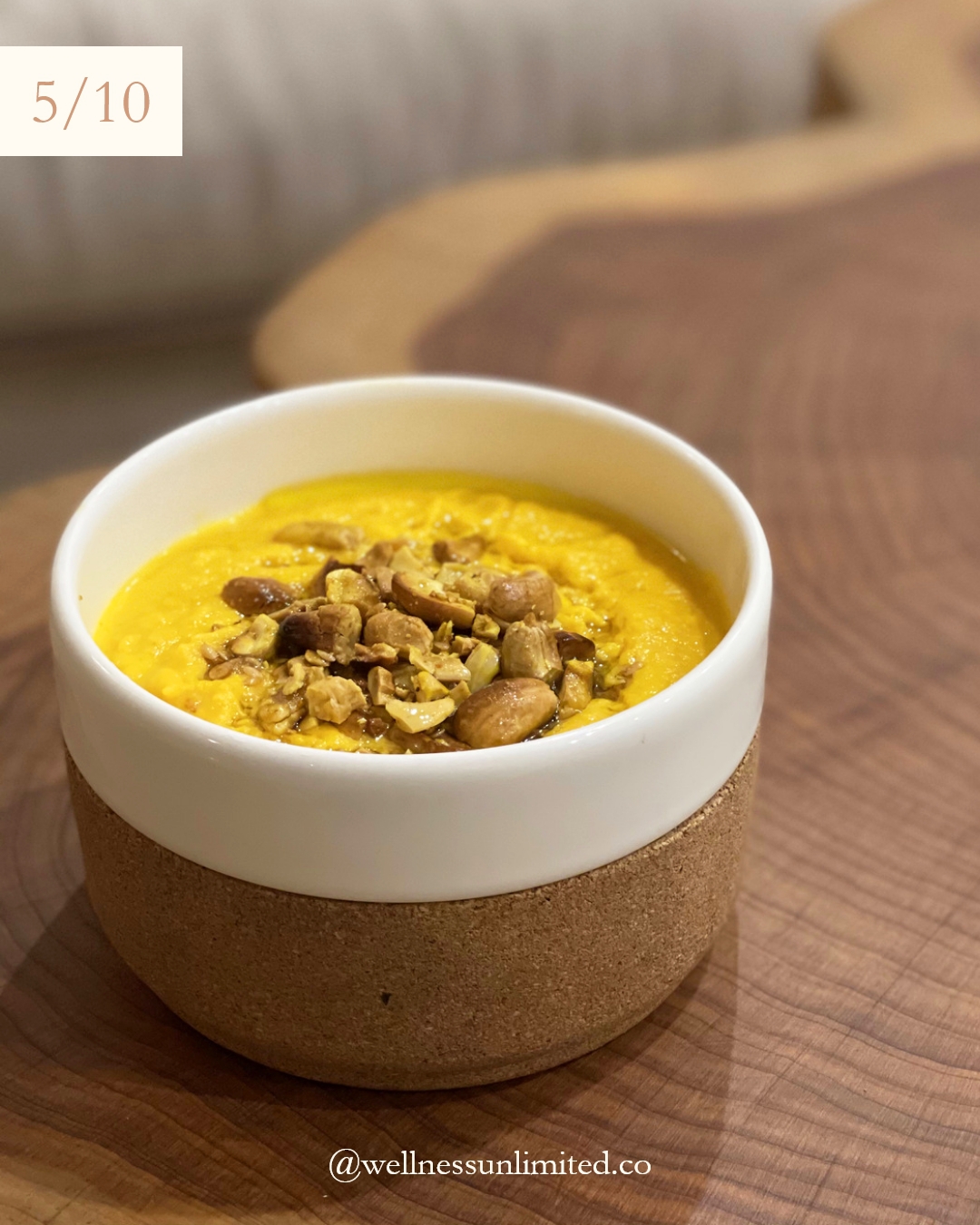
Ingredients:
- Extra virgin olive oil
- 3 shallots
- Ginger
- Spices: turmeric, cumin
- 6 carrots
- 2 cups water
- 400ml coconut milk
- Juice of 2 limes
- Cashews
- Flaxseeds
Method:
- Saute the shallots in extra virgin olive oil;
- Add small chunks of fresh ginger and give it a stir;
- Add in the carrots cut in medium chunks and follow with spices. Give it a good stir and pour the water. Salt to taste;
- Pour the coconut milk and lime juice;
- In the meantime, toss crushed cashews with flaxseeds, olive oil and turmeric in the oven; once golden, put them to one side;
- Remove the soup from the stove and blend until the texture is smooth. Bring back to the stove for 5 minutes;
- Can serve with a drizzle of olive oil and the roasted cashew mix for added flavor and nutrients.
6. Sweet Potato Spinach Soup
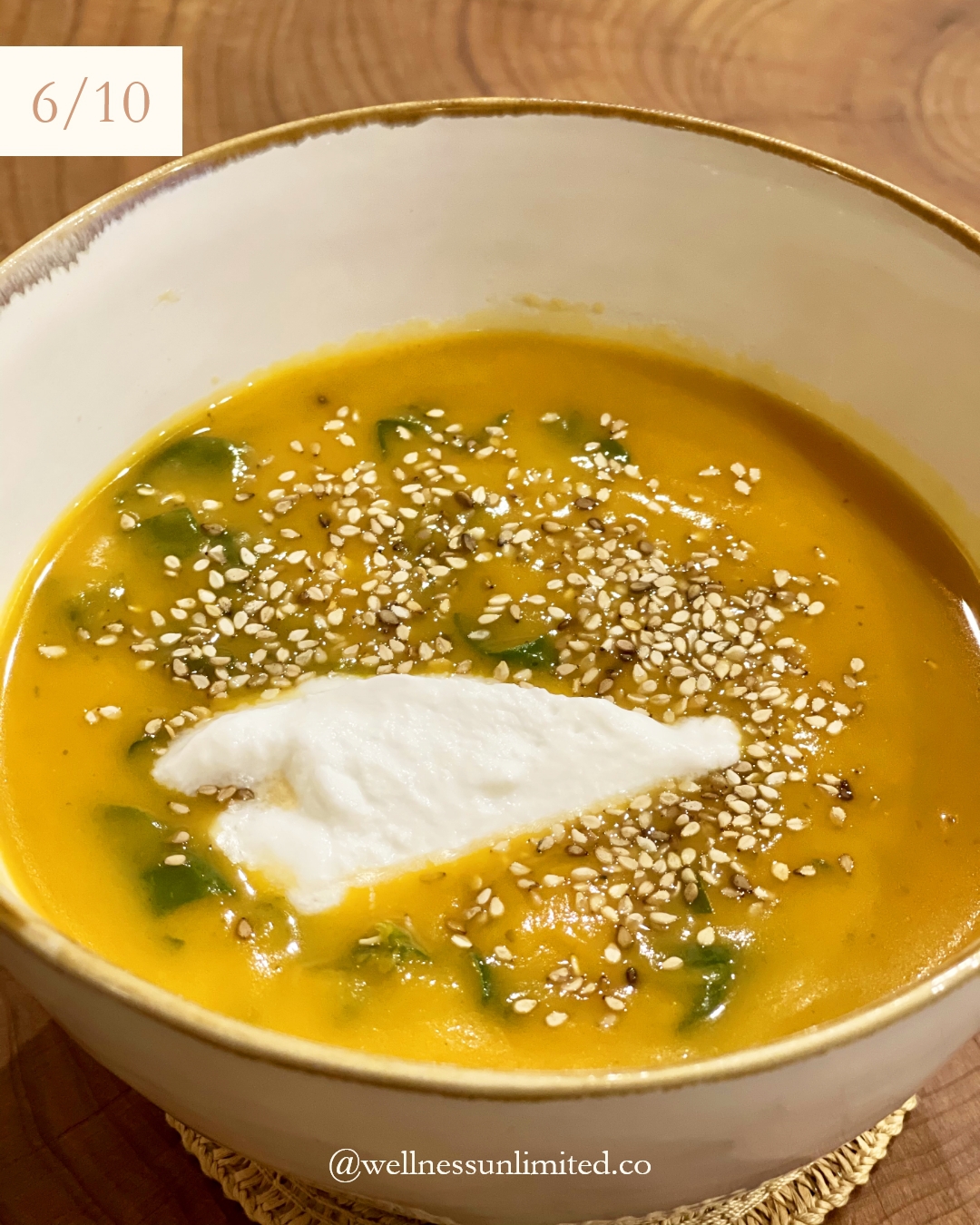
Ingredients:
- Extra virgin olive oil
- 3 sweet potatoes
- Oregano
- 3 cups water
- 2 handfuls fresh spinach
- Yogurt (vegan coconut)
- Sesame seeds
Method:
- Slice the sweet potatoes in two and place in a baking tray with olive oil, salt and oregano. Roast until soft and scoop out the puree;
- Blend the sweet potatoes with olive oil and the water so it makes a mix that is not too thick. Bring to a boil. Add in the spinach and keep stirring until they are cooked;
- Serve with sesame seeds and a spoon of coconut yogurt.
7. Saag Dal
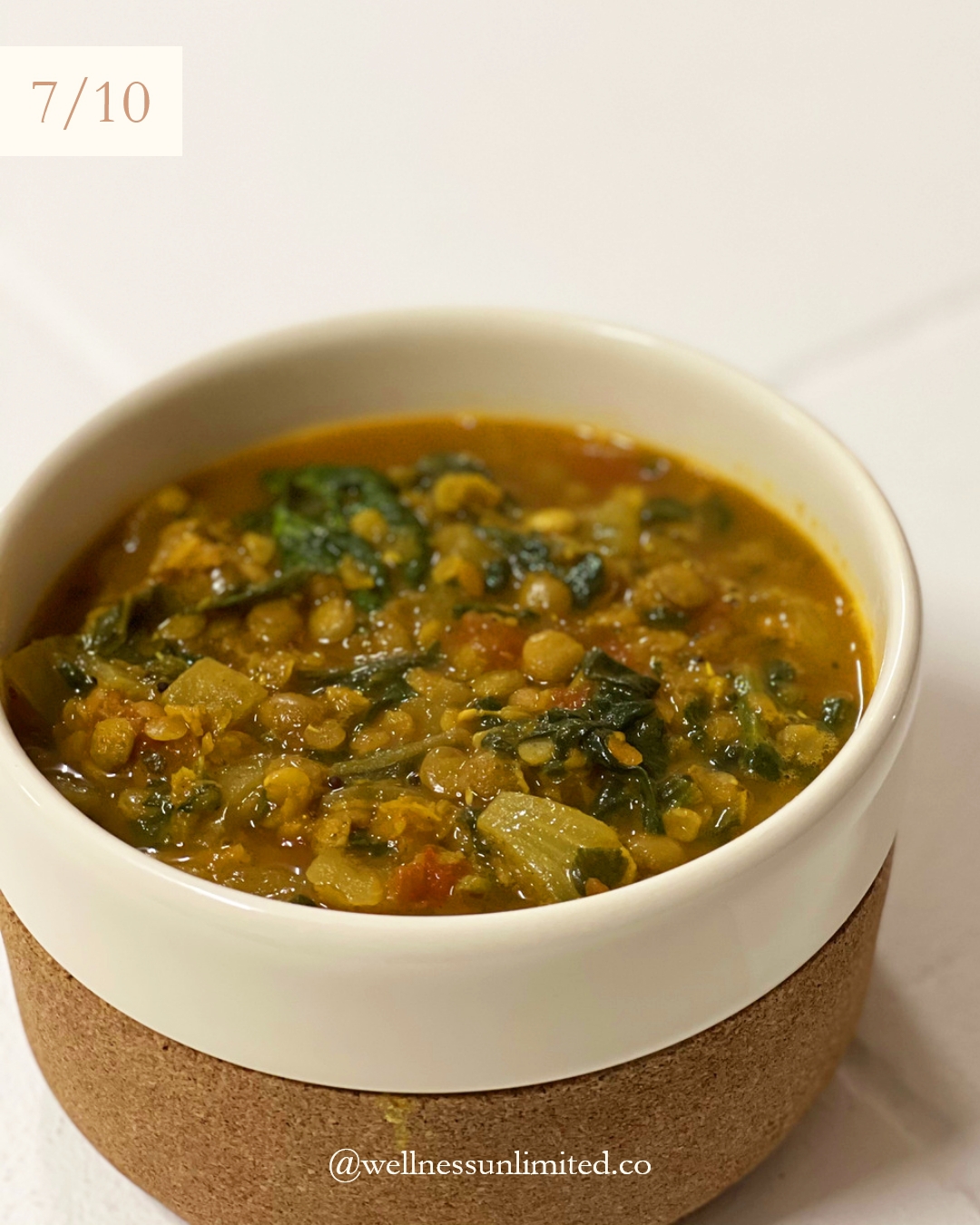
Ingredients:
- Extra virgin olive oil
- 1 onion
- Garlic
- Ginger
- Spices: mustard seeds, cumin seeds, turmeric, garam masala
- 1 cup red split lentils
- ½ cups green split lentils
- 3 cups of water
- 6 cubes frozen spinach
- 3 handful fresh spinach baby leaves
- 1 jar peeled tomatoes
- Juice of 1 lemon
Method:
- Saute the onion in extra virgin olive oil until softened;
- Add in finely chopped garlic and ginger, then stir in for a few more minutes;
- Then add in the spices and keep stirring to coat the onion, garlic and ginger mix;
- Add in the washed lentils and pour the water;
- Mix in the frozen and/or fresh spinach, the tomatoes and lemon juice and bring to a boil;
- Serve warm once the lentils are fully cooked and tender.
8. Harira
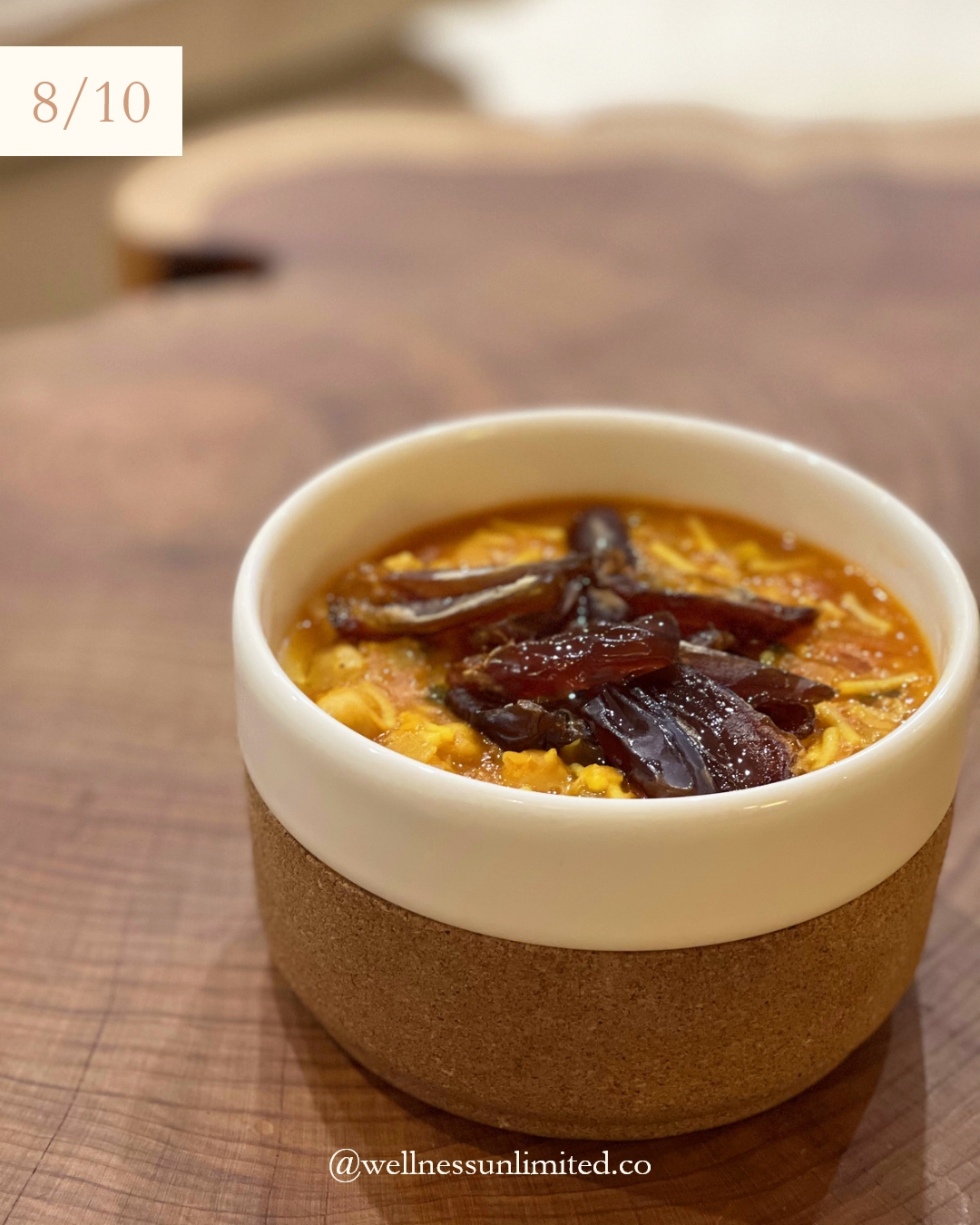
Ingredients:
- Extra virgin olive oil
- Argan oil
- 1 onion
- Ginger
- Garlic
- 2 to 3 celery stalks
- Spices: turmeric, cumin, cinnamon, saffron, Moroccan spice mix
- 1 spoon harissa
- Jar / fresh tomatoes
- 6 cups veg stock
- 1 jar chickpeas
- ½ cup red split lentils
- ½ cup vermicelli
- Juice of 1 lemon
- Some dates
Method:
- Saute the onion in extra virgin olive oil until softened;
- Add in finely chopped garlic and ginger and stir; add the celery and keep stirring for a few more minutes. Incorporate the spices to cover the mix;
- Then add in the washed lentils, chickpeas, tomatoes and keep stirring;
- After a few minutes, add in the vegetable stock, vermicelli, harissa and finish with the lemon juice;
- Remove the stone and slice your dates lengthwise to garnish;
9. Creamy Pepper Cashew Soup
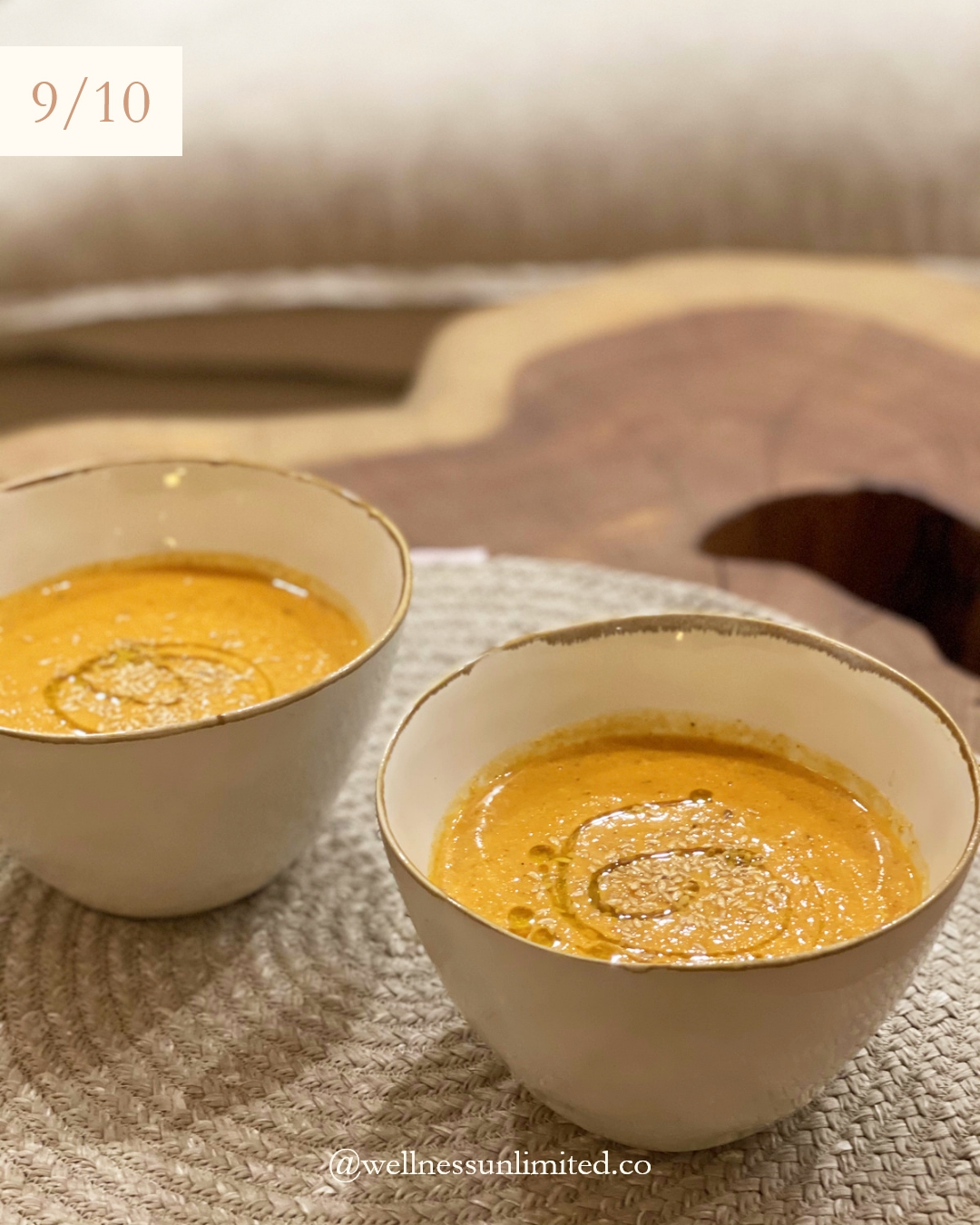
Ingredients:
- Extra virgin olive oil
- 2 shallots
- 2 red peppers
- Fresh tomatoes or pulp
- 2 carrots
- Spices: oregano, cumin, turmeric, paprika
- 1 handful cashews
- 400g chickpeas
- 650ml veg stock
- 1 handful flaxseeds
Method:
- Saute the onion in extra virgin olive oil. Add in the shallots, peppers and carrots and cook until softened;
- Once the vegetables are cooked, remove from the stove and add to a blender with the rest of the ingredients; blend until you achieve a smooth texture;
- Then bring the mix back to the stove and let it cook for 5 to 10 minutes on medium to low heat. Salt to taste;
- Can serve with a drizzle of olive oil and flaxseeds.
10. Tomato Watercress Bean Soup
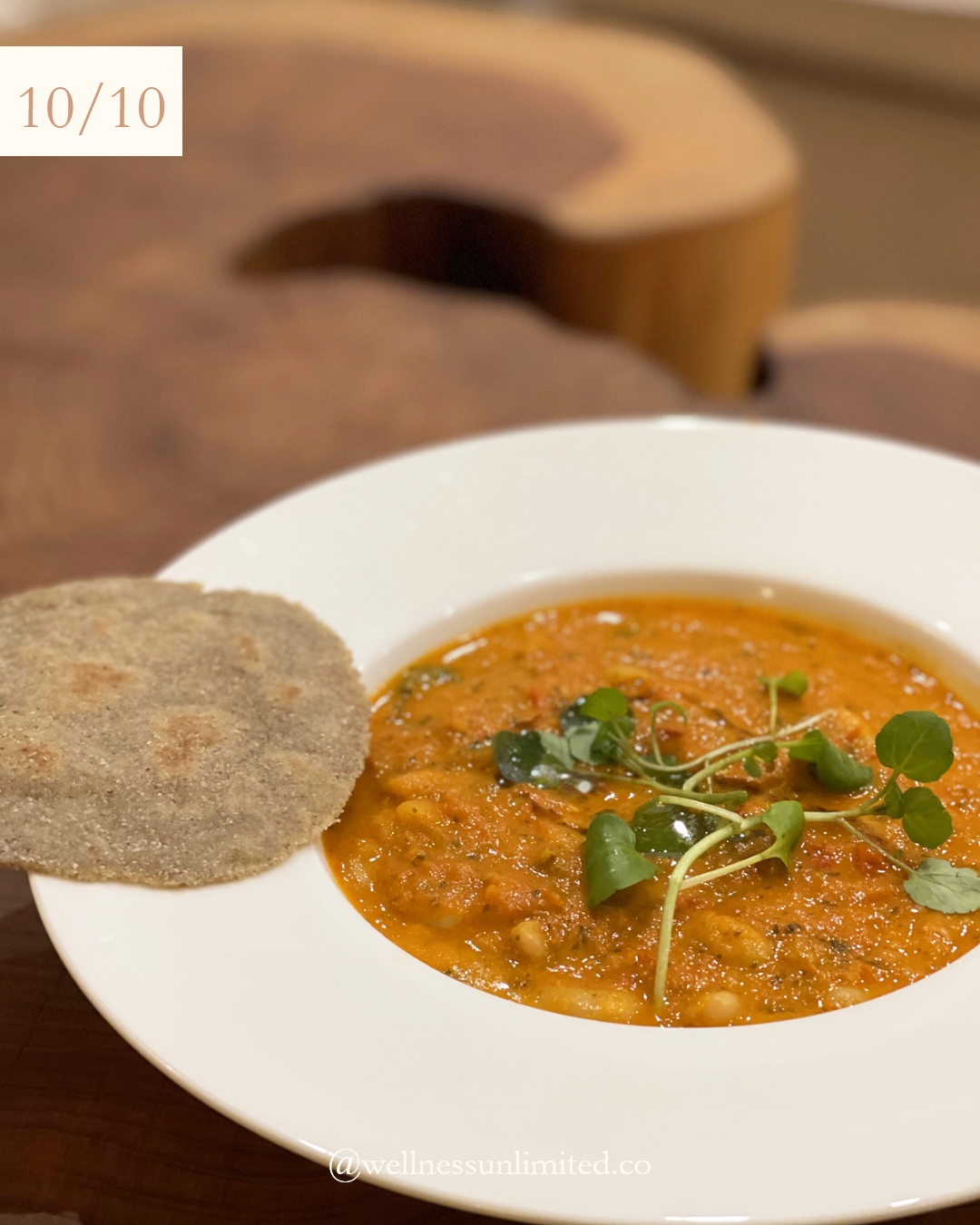
Ingredients:
- Extra virgin olive oil
- 2 shallots
- Garlic
- Cherry tomatoes
- Spices: turmeric, pepper
- 1 bunch of watercress
- Medium jar of white beans
Method:
- Saute the shallots in extra virgin olive oil. Add in the finely chopped garlic and stir for another few minutes before mixing in the spices;
- Add the fresh (or tinned) tomatoes and half of your watercress;
- Salt to taste;
- Once the tomatoes are soft and starting to melt, remove the warm winter soup from the stove and blend until you achieve a semi smooth texture. Toss in the rest of your watercress (keep a few leaves for the end) and the washed white beans. Bring back to the stove for 5 minutes;
- Can serve with a drizzle of olive oil and a couple of watercress leaves for garnish.
I hope you enjoyed reading this blog on quick warming plant based stew & warm winter soup recipes. Maybe it even inspired you to try out more ways to cook vegetables in the autumn and winter!
I can’t wait to see you unleash your inner intuitive chef; don’t forget to tag me if you cook a stew or warm winter soup inspired by one of the recipes, it would certainly warm me up 🙂



